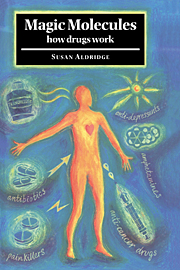Book contents
- Frontmatter
- Contents
- List of illustrations
- Acknowledgements
- Introduction
- 1 How drugs work
- 2 From penicillin to Prozac: introducing pharmaceutical drugs
- 3 Fighting infection
- 4 The hormonal revolution
- 5 Cardiovascular drugs: protecting the heart and brain
- 6 The problem of pain
- 7 The cancer challenge
- 8 Drugs for the mind
- 9 Drugs of recreation and addiction
- 10 Natural alternatives: vitamins, minerals and herbs
- 11 In the pipeline: gene-based medicine
- Bibliography
- Index
5 - Cardiovascular drugs: protecting the heart and brain
Published online by Cambridge University Press: 05 August 2012
- Frontmatter
- Contents
- List of illustrations
- Acknowledgements
- Introduction
- 1 How drugs work
- 2 From penicillin to Prozac: introducing pharmaceutical drugs
- 3 Fighting infection
- 4 The hormonal revolution
- 5 Cardiovascular drugs: protecting the heart and brain
- 6 The problem of pain
- 7 The cancer challenge
- 8 Drugs for the mind
- 9 Drugs of recreation and addiction
- 10 Natural alternatives: vitamins, minerals and herbs
- 11 In the pipeline: gene-based medicine
- Bibliography
- Index
Summary
Cardiovascular (CV) disease, the name given to all those conditions which affect the heart and circulation, has become an increasingly important target for the pharmaceutical industry over the last 20 years or so. Nine of the top 20 best-selling drugs are for treating CV disease (Table 1). This is hardly surprising, since the market is enormous.
The two main areas of CV disease are coronary heart disease (CHD) and stroke. In the UK, CV disease accounts for around 300,000 deaths every year– nearly half of the total number of deaths. Half of these deaths are from CHD, and a quarter are from stroke (the rest are due to related conditions).
However, the mortality from CHD has been falling in the UK since the late 1970s. Today slightly more people die of some form of cancer than of CHD. A similar downward trend is seen in many other countries in the world (Fig. 5.1), especially in the United States. Britain still has one of the highest rates of CHD in the world, exceeded only by figures for Eastern Europe and the former Soviet Union, where – alarmingly – rates are actually increasing. Coronary heart disease levels are particularly low in some Mediterranean countries such as France and Italy, and lowest of all in Japan. No one is sure of the reasons for these various trends, and the differences in CHD rates between different countries, but they reflect the impact of an interplay of both lifestyle factors and genetics. Cardiovascular drugs work alongside lifestyle changes to improve the outlook for those affected by CV disease, while genetic research may, in the future, pinpoint those who stand to benefit most from their use (see also Chapter 11).
- Type
- Chapter
- Information
- Magic MoleculesHow Drugs Work, pp. 115 - 142Publisher: Cambridge University PressPrint publication year: 1998



